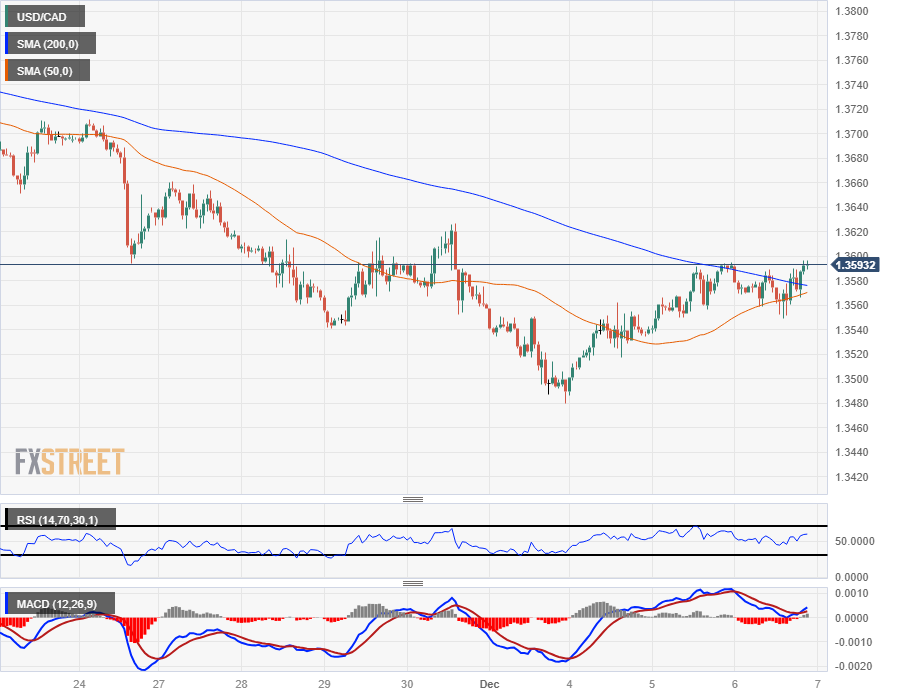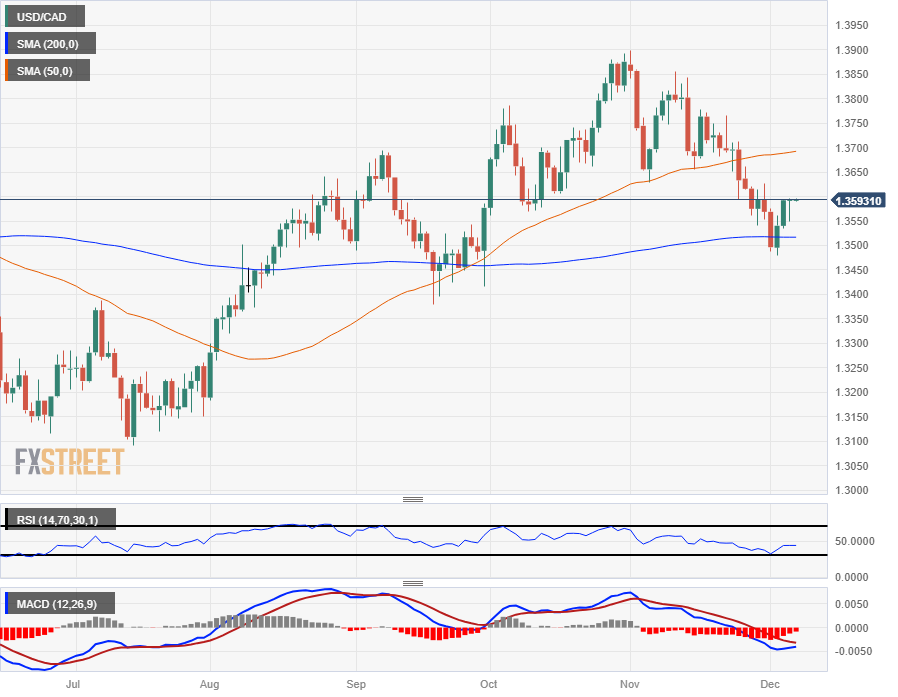Most recent post: Canadian Dollar weakens across the board on Thursday as US NFP looms ahead
- The Canadian Dollar fell back once more on Wednesday, losing further ground.
- The BoC held rates at 5% as the markets broadly expected.
- The CAD gave up the day's early gains on the USD, remains down for the week.
The Canadian Dollar (CAD) saw minor gains on Wednesday, but struggled to make headway after the Bank of Canada (BoC) decided to hold its benchmark interest rate at 5%, in-line with market expectations. The CAD saw a brief step up against most of the major currency blocs before slipping back into a mixed bag.
The Canadian Dollar has given up all of the day's gains and is now down three-quarters of a percent against the US Dollar (USD) for the week.
The Bank of Canada (BoC) held rates steady for the third straight meeting in a row, leaving enough hawkish wiggle room on the table to warn that further rate hikes would follow if inflation risks increase.
Daily Digest Market Movers: Canadian Dollar stretches for more after BoC rate hold
- The Canadian Dollar is on the move against the US Dollar, looking to recover ground after getting pushed lower against the Greenback in the early week run-up to the BoC’s rate call.
- The BoC held its benchmark rate at 5% just as markets expected.
- The Canadian central bank also cooled its hawkish rhetoric, paring back statements about inflation risks and keeping the focus on easing price pressures.
- The BoC left some hawkish statements on the table, reiterating that rates can and will go higher if inflationary pressure returns.
- BoC Statement: “Governing Council wants to see further and sustained easing in core inflation, and continues to focus on the balance between demand and supply in the economy, inflation expectations, wage growth and corporate pricing behaviour.”
- US ADP Employment Change figures missed the mark on Wednesday, introducing some jitters into USD-based currency pairs.
- The US ADP Employment Change for November showed 103K new jobs added to the US economy, below the forecasted upswing to 130K and falling back from October’s 106K (revised down from 113K).
- US Initial Jobless Claims for the week of November 24 will be the notable data release on Thursday before markets round the corner into Friday’s US Nonfarm Payrolls (NFP).
Canadian Dollar price this week
The table below shows the percentage change of Canadian Dollar (CAD) against listed major currencies this week. Canadian Dollar was the weakest against the US Dollar.
| USD | EUR | GBP | CAD | AUD | JPY | NZD | CHF | |
| USD | 1.13% | 1.21% | 0.76% | 1.99% | 0.65% | 1.26% | 0.80% | |
| EUR | -1.16% | 0.09% | -0.37% | 0.88% | -0.50% | 0.15% | -0.33% | |
| GBP | -1.24% | -0.06% | -0.44% | 0.80% | -0.55% | 0.05% | -0.40% | |
| CAD | -0.77% | 0.37% | 0.46% | 1.24% | -0.13% | 0.51% | 0.04% | |
| AUD | -2.03% | -0.89% | -0.80% | -1.26% | -1.39% | -0.73% | -1.22% | |
| JPY | -0.69% | 0.51% | 0.74% | 0.13% | 1.37% | 0.64% | 0.15% | |
| NZD | -1.28% | -0.14% | -0.06% | -0.50% | 0.74% | -0.62% | -0.50% | |
| CHF | -0.82% | 0.34% | 0.42% | -0.03% | 1.20% | -0.15% | 0.47% |
The heat map shows percentage changes of major currencies against each other. The base currency is picked from the left column, while the quote currency is picked from the top row. For example, if you pick the Euro from the left column and move along the horizontal line to the Japanese Yen, the percentage change displayed in the box will represent EUR (base)/JPY (quote).
Technical Analysis:
The Canadian Dollar (CAD) clipped into marginal gains on Wednesday, only losing ground against the Aussie (AUD) and the Kiwi (NZD) for the mid-week market session before falling back through the American market session. The CAD gained around a tenth of a percent against the US Dollar (US) before retreating back into new lows on the day, dragging the USD/CAD back towards the 1.3600 handle.
The USD/CAD gained ground in the early week, taking the pair from opening bids near 1.3495 directly into the 200-hour Simple Moving Average (SMA) just below the 1.3600 handle.
The Canadian Dollar is in the green for the week against everything except the safe havens. Despite the Loonie’s bid on Wednesday, the USD/CAD still remains down around half a percent from Monday’s opening bids.
USD/CAD Hourly Chart

USD/CAD Daily Chart

Canadian Dollar FAQs
What key factors drive the Canadian Dollar?
The key factors driving the Canadian Dollar (CAD) are the level of interest rates set by the Bank of Canada (BoC), the price of Oil, Canada’s largest export, the health of its economy, inflation and the Trade Balance, which is the difference between the value of Canada’s exports versus its imports. Other factors include market sentiment – whether investors are taking on more risky assets (risk-on) or seeking safe-havens (risk-off) – with risk-on being CAD-positive. As its largest trading partner, the health of the US economy is also a key factor influencing the Canadian Dollar.
How do the decisions of the Bank of Canada impact the Canadian Dollar?
The Bank of Canada (BoC) has a significant influence on the Canadian Dollar by setting the level of interest rates that banks can lend to one another. This influences the level of interest rates for everyone. The main goal of the BoC is to maintain inflation at 1-3% by adjusting interest rates up or down. Relatively higher interest rates tend to be positive for the CAD. The Bank of Canada can also use quantitative easing and tightening to influence credit conditions, with the former CAD-negative and the latter CAD-positive.
How does the price of Oil impact the Canadian Dollar?
The price of Oil is a key factor impacting the value of the Canadian Dollar. Petroleum is Canada’s biggest export, so Oil price tends to have an immediate impact on the CAD value. Generally, if Oil price rises CAD also goes up, as aggregate demand for the currency increases. The opposite is the case if the price of Oil falls. Higher Oil prices also tend to result in a greater likelihood of a positive Trade Balance, which is also supportive of the CAD.
How does inflation data impact the value of the Canadian Dollar?
While inflation had always traditionally been thought of as a negative factor for a currency since it lowers the value of money, the opposite has actually been the case in modern times with the relaxation of cross-border capital controls. Higher inflation tends to lead central banks to put up interest rates which attracts more capital inflows from global investors seeking a lucrative place to keep their money. This increases demand for the local currency, which in Canada’s case is the Canadian Dollar.
How does economic data influence the value of the Canadian Dollar?
Macroeconomic data releases gauge the health of the economy and can have an impact on the Canadian Dollar. Indicators such as GDP, Manufacturing and Services PMIs, employment, and consumer sentiment surveys can all influence the direction of the CAD. A strong economy is good for the Canadian Dollar. Not only does it attract more foreign investment but it may encourage the Bank of Canada to put up interest rates, leading to a stronger currency. If economic data is weak, however, the CAD is likely to fall.
Information on these pages contains forward-looking statements that involve risks and uncertainties. Markets and instruments profiled on this page are for informational purposes only and should not in any way come across as a recommendation to buy or sell in these assets. You should do your own thorough research before making any investment decisions. FXStreet does not in any way guarantee that this information is free from mistakes, errors, or material misstatements. It also does not guarantee that this information is of a timely nature. Investing in Open Markets involves a great deal of risk, including the loss of all or a portion of your investment, as well as emotional distress. All risks, losses and costs associated with investing, including total loss of principal, are your responsibility. The views and opinions expressed in this article are those of the authors and do not necessarily reflect the official policy or position of FXStreet nor its advertisers. The author will not be held responsible for information that is found at the end of links posted on this page.
If not otherwise explicitly mentioned in the body of the article, at the time of writing, the author has no position in any stock mentioned in this article and no business relationship with any company mentioned. The author has not received compensation for writing this article, other than from FXStreet.
FXStreet and the author do not provide personalized recommendations. The author makes no representations as to the accuracy, completeness, or suitability of this information. FXStreet and the author will not be liable for any errors, omissions or any losses, injuries or damages arising from this information and its display or use. Errors and omissions excepted.
The author and FXStreet are not registered investment advisors and nothing in this article is intended to be investment advice.
Recommended content
Editors’ Picks
EUR/USD climbs to daily highs near 1.0770 on Dollar selling

EUR/USD manages to regain extra upside traction on the back of the renewed sell-off in the Greenback, reaching fresh daily highs in the 1.0770 region, or. two-day peaks.
GBP/USD hovers around 1.2500 post-BoE

GBP/USD alternates gains with losses around the 1.2500 neighbourhood amidst extra weakness in the Dollar, while market participants continue to digest the BoE event.
Gold poised to resume its advance

XAU/USD now gathers fresh steam and advances to the highest level in many sessions north of the $2,330 mark per troy ounce on the back of further selling pressure hurting the Greenback as well as mixed US yields.
Solana meme coins TREMP, BODEN rise after Donald Trump’s pro-crypto stance

Solana-based meme coins TREMP and BODEN post nearly 125% and 7% gains on Thursday. Former US President Donald Trump says his campaign will likely accept crypto donations.
Bank of England inches one step closer to a summer rate cut

The Bank of England is undoubtedly turning more optimistic, but it’s keeping its options open amid some uncertainty surrounding the near-term inflation numbers. We still narrowly expect the first rate cut in August.